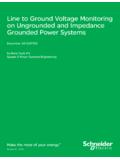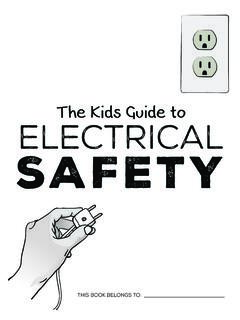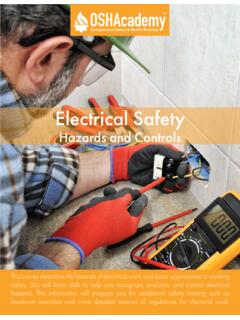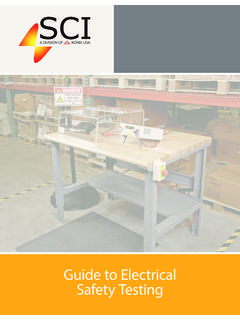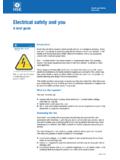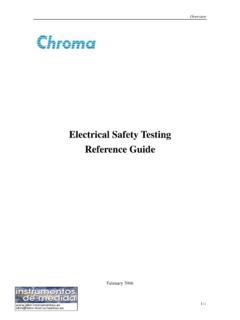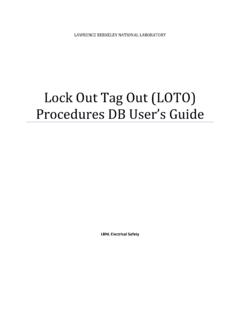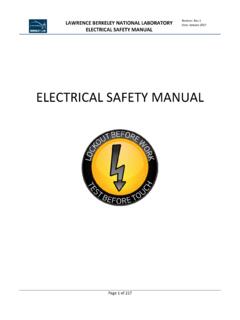Transcription of Guide to Compliance with the Electrical Workplace Safety ...
1 Guide to Compliance with theElectrical Workplace SafetyStandards in the United StatesJuly 2011/1910DB1102 by Joseph H. Weigel, Product ManagerSchneider Electric USA, the most of your energy SM2 | White paper for Compliance with Electrical Safety standardsGuide to Compliance with the Electrical Workploace Safety standards in the United Abstract .. Introduction .. Required Steps for Reducing the Risk of Electrical Accidents Establish an Electrical Safety Program ..5 Conduct an Electrical System Study to Determine the the Degree of Arc Flash Hazard ..5 Safety Training ..6 Personal Protective Clothing and Equipment ..7 Proper Tools for Safe Electrical Work ..7 Equipment Warning Labels .. Additional Best Practices Appoint an Electrical Safety Program Manager.
2 8 Maintain Electrical Distribution System Components ..8 Maintain and Update Electrical Distribution System Documentation .. Conclusion .. References ..9 Guide to Compliance with the Electrical Workplace Safety standards in the United StatesWhite paper for Compliance with Electrical Safety standards | AbstractThis paper presents an overview of the NFPA 70E 2009 Standard for Electrical Safety in the Workplace and the requirements of the standards which are intended to better protect Electrical workers from injury when they work on energized Electrical IntroductionFive to 10 times per day in the United States, a worker is severely injured or killed in an Electrical arc flash accident. Other Electrical incidents can also injure workers; these typically involve accidental con-tacts with energized parts that result in shock and electrocution.
3 The injuries and fatalities that result from these accidents are always devastating to the workers and their families. Additionally, the financial consequences of such events can be very damaging to the to Compliance with the Electrical Workploace Safety standards in the United States4 | White paper for Compliance with Electrical Safety standardsThere are important steps that companies can take to reduce the occurrence of Electrical accidents and better protect the worker and the employer from the physical, financial and statu-tory consequences of Electrical accidents. Following are the required steps for reducing the risk of electri-cal accidents. Many of these steps are required as part of The National Fire Protection Association (NFPA), in its standard 70E 2009, which provides a detailed reference for facilities to meet the requirements of Electrical Workplace Safety .
4 Additional steps are recommended and considered best practices for improving overall Safety within a facility. Clearly, the fundamental requirement for Electrical Safety is always to place Electrical equipment in an electrically safe con-dition whenever possible through a proper lock out / tag out pro-cedure. But NFPA 70E 2009 provides additional best practices for Electrical Safety , and these are recognized and enforced by Required Steps for Reducing theRisk of Electrical Establish an Electrical Safety Program with Defined Responsibilities This is a written document created by the employer that covers all areas of the com-pany s Electrical Safety policies, and includes such things as lock out/tag out proce-dures, internal Safety policies and clearly-defined responsibilities for Electrical Conduct an Electrical System Study to Determine the Degree of Arc Flash HazardThis is an Electrical system engineering study that is performed by engineers familiar with the power distribution and control equipment and the calculation methods required.
5 The arc flash analysis will determine, among other things, the incident energy potential of each piece of Electrical distribution equipment in the facility. This incident energy potential will define the Hazard/Risk Category of personal protective equipment (PPE) that the employee is required to wear while performing any work when energized parts are exposed. The methodology for conducting these arc flash analyses is outlined in IEEE 1584 Guide for Performing Arc-Flash Hazard alternative to a detailed arc flash analysis that is permitted in NFPA 70E 2009 Article Exception Number 2, is to use the task tables in (C)(9) to determine the required PPE Hazard Risk cate-gory. The tables each have usage limitations as stated in the footnotes. The footnotes typically specify a range of available fault current and clearing time for the upstream over-current protective device beyond which the tables may not be safely used.
6 Unless a detailed arc flash analysis has been performed, users will usually not know these details, and this commonly leads to misuse of the task tables, which can lead to under-protection for the to Compliance with the Electrical Workplace Safety standards in the United StatesWhite paper for Compliance with Electrical Safety standards | 5 The task tables are based on some calculated values within the limits of the stated footnotes, but also include the probability of causing an arc flash based on the task being performed. This probability factor is highly variable and subjective, and can potentially lead to significant under-protection. Since the NFPA 70E 2009 Article (C) now requires that the equipment be labeled with either the incident energy in calories per square centimeter or the PPE hazard Risk Category, using the tables creates a problem with labeling as well.
7 Relying on a detailed arc flash analysis for PPE selection is always a preferred and more accurate Conduct Safety Training for All WorkersNFPA 70E defines a qualified person as one who has skills and knowledge related to the construction and operation of the Electrical equipment and systems, and has received Safety training to recognize and avoid the hazards involved. This training requirement means that the employee must have received Safety training specific to the hazards of arc flash, arc blast, shock and electrocution. Electrical workers are not considered to be qualified by OSHA until they have received this specific to Compliance with the Electrical Workploace Safety standards in the United States6 | White paper for Compliance with Electrical Safety Required Steps for Reducing theRisk of Electrical Accidents (con t.)
8 Photo Oberon Company Ensure There is Adequate Personal Protective Clothing and Equipment on HandEmployees working in areas where there are potential Electrical hazards shall be pro-vided with Electrical protective equipment that is appropriate for the specific parts of the body to be protected and for the work to be performed. This can include fire-resis-tant shirt, pants or coveralls, or a multi-layer flash Ensure the Proper Tools are on Hand for Safe Electrical Work In addition to PPE, the standards require the employer to furnish other tools for safe Electrical work. This includes insulated voltage rated hand tools and insulated voltage sensing devices that are properly rated for the voltage application of the equipment to be Apply Warning Labels to All EquipmentCurrently, NFPA 70 dated 2008 (National Electric Code) states in article - Flash Protection.
9 Electrical equip-ment, such as switchboards, panelboards, industrial control panels, meter socket enclosures, and motor control centers that are in other than dwelling occupancies and are likely to require examination, adjustment, servicing, or maintenance while energized shall be field marked to warn qualified persons of potential electric arc flash hazards. The marking shall be located so as to be clearly visible to qualified persons beforeexamination, adjustment, servicing, or maintenance of the equipment. The current NEC requirement for application of hazard warn-ing labels on Electrical equipment, the National Electrical Code (NEC) 2008, does not require that the specific information, such as the PPE Hazard/Risk Category, incident energy, boundary distances and other data that would be provided by the arc flash hazard analysis, must be included on the label.
10 However, the current NFPA 70E 2009, in article (C) has elevated the labeling requirement by stating Equipment shall be field marked with a label con-taining either the incident energy or required level of PPE. Required Steps for Reducing theRisk of Electrical Accidents (con t.) Guide to Compliance with the Electrical Workplace Safety standards in the United StatesWhite paper for Compliance with Electrical Safety standards | 7 Example of equipment-specific arc flash Additional Best Practices Appoint an Electrical Safety Program ManagerIdentify a Safety professional from your organization who has vast knowledge and experience within the Electrical industry. This should be a well-organized, responsible individual who will take the position seriously. Having a single individual who is famil-iar with Electrical code requirements and other Safety issues will pay off.
